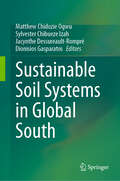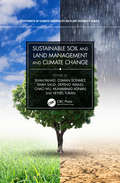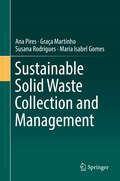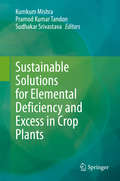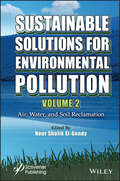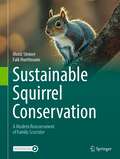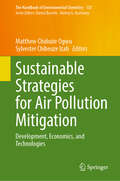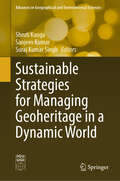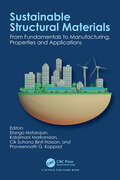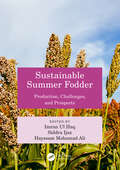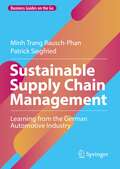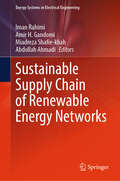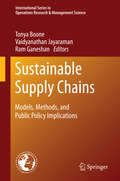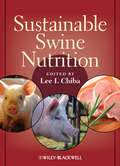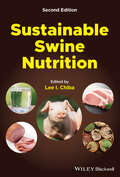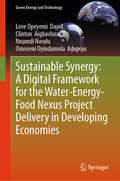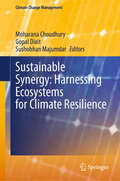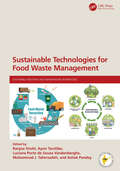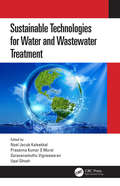- Table View
- List View
Sustainable Soil Systems in Global South
by Sylvester Chibueze Izah Matthew Chidozie Ogwu Jacynthe Dessureault-Rompré Dionisios GasparatosWith a focus on soil systems (status, properties, functionality, diagnosis, roles, assessment, conservation, knowledge, practices, productivity, management, policies, climate, biodiversity, etc.), this book addresses gaps pertinent to promoting sustainable human-environment in the Global South and beyond. The soil system is a complex and dynamic part of the lithosphere with flows, inputs, storage, and output that connects it with other Earth systems. It is a living unit whose physical, chemical, and biological characteristics are dependent on the process of its formation, parent material, age, organic and inorganic constituent, and climate and relief. From a systems standpoint, balancing the relationship between utilization and management will help maintain soil health and the provision of ecosystem services. A healthy soil system is capable of functioning as a living unit to support other life and life processes and contribute to sustainable development in the Global South. This book is of interest and useful to soil, biological and agricultural scientists, trainees and trainers, agricultural institutes, soil and food systems specialists, biodiversity and environmental managers, practitioners, activists, and students (especially undergraduates and postgraduates) in the Global South and beyond.
Sustainable Soil and Land Management and Climate Change (Footprints of Climate Variability on Plant Diversity)
by Shah Fahad Muhammad Adnan Shah Saud Depeng Wang Chao Wu Veysel Turan Osman SönmezThe third volume of Sustainable Soil and Land Management and Climate Change presents a complete overview of plant soil interactions in a climate affected by greenhouse gas emissions and organic carbon. It presents approaches and managements strategies for the stabilization of soil organic matter.The latest in the respected Footprints of Climate Variability on Plant Diversity series, this book enhances the reader’s knowledge of the preservation of organic matter through microbial approaches as well as through soil and plant interactions. Written by teams of specialist scientists, it presents research outcomes, practical applications and future challenges for this important field.Features: Presents microbial tactics for the alleviation of potentially toxic elements in agricultural soils and for reclaiming saline soil. Provides an overview of scientific investigations into greenhouse gas emissions. Outlines priming techniques developed in response to a changing climate. This book is written for students of agronomy, soil science and the environmental sciences as well as researchers interested in management technologies to improve soil fertility.
Sustainable Solar Electricity (Green Energy and Technology)
by Antonio UrbinaThis book provides a detailed life cycle assessment of photovoltaic technologies in order to analyse the environmental and socioeconomic impacts that a large deployment of solar photovoltaic systems will produce in the near future. Including both commercial and emerging technologies, the book presents the energy and materials requirements to manufacture solar electricity power systems at the order of the TeraWatt scale deployment as is envisaged by the International Renewable Energy Agency (IRENA) for the near future. It discusses current manufacturing practices and how these may be adapted in the future including: reuse and recycling of components and materials; raw material supply chains to the manufacturing factories; and end-of-life procedures including recycling and landfilling of modules. The environmental and socioeconomic impacts of solar energy are analysed in detail, providing recommendations for standardization and regulations in order to make photovoltaic technologies, both current and emerging, a really sustainable alternative for the supply of “greener” electricity.
Sustainable Solid Waste Collection and Management
by Ana Pires Graça Martinho Susana Rodrigues Maria Isabel GomesThis volume focuses on the collection of waste and waste streams as an integral aspect of sustainable waste management. The authors take economic models and behavioral studies into account to go beyond just descriptions of waste collections technologies and collection route design. Models and tools for sustainable waste collection are described in detail, and the authors provide a comprehensive, integrated methodology to design waste collection systems that reduce environmental impacts, are economically viable, and achieve buy-in and participation from target populations. Part I of the book provides fundamentals and context on waste hierarchy, including waste prevention, reduction and reuse, waste collection itself, and steps such as preparation for recycling, recycling, treatment, and landfilling. Background in environmental, social, and economic concerns surrounding waste collection is also provided here. Part II addresses tools for design, operation, and maintenance of waste collection systems. Part III focuses on how the tools presented in Part II can be used to support sustainability assessments and decisions that consider the entire life cycle of waste and the role of waste collection programs in waste prevention, reduction, reuse, recycling, treatment, and disposal. Part IV addresses the challenges of developing sustainable waste management systems and addresses the role of waste collection in sustainable waste management in the future.
Sustainable Solutions for Elemental Deficiency and Excess in Crop Plants
by Sudhakar Srivastava Kumkum Mishra Pramod Kumar TandonThis book covers all aspects of deficiency of essential elements and excess of toxic ones in crop plants. The metal deficiency and toxicity are the two sides of same problem that are threatening to sustainable agricultural growth. The book presents prospective strategies for the management of elemental nutrition of crop plants. Chapters are arranged in a manner so as to develop a lucid picture of the topic beginning from basics to advanced research. The content is supplemented with flow charts and figures to make it convenient for readers to holistically grasp the concepts. It will be a value addition for students, research scholars and professionals in understanding the basics as well latest developments in the area of metal deficiency and excess in crop plants.
Sustainable Solutions for Environmental Pollution, Volume 2: Air, Water, and Soil Reclamation
by Nour Shafik El-GendySUSTAINABLE SOLUTIONS FOR ENVIRONMENTAL POLLUTIONS This second volume in a broad, comprehensive two-volume set, “Sustainable Solutions for Environmental Pollution”, concentrates on air, water, and soil reclamation, some of the biggest challenges facing environmental engineers and scientists today. This second, new volume in the two-volume set, Sustainable Solutions for Environmental Pollution, picks up where volume one left off, covering the remediation of air, water, and soil environments. Outlining new methods and technologies for all three environmental scenarios, the authors and editor go above and beyond, introducing naturally-based techniques in addition to changes and advances in more standard methods. Written by some of the most well-known and respected experts in the field, with a prolific and expert editor, this volume takes a multidisciplinary approach, across many scientific and engineering fields, intending the two-volume set as a “one-stop shop” for all of the advances and emerging techniques and processes in this area. This groundbreaking new volume in this forward-thinking set is the most comprehensive coverage of all of these issues, laying out the latest advances and addressing the most serious current concerns in environmental pollution. Whether for the veteran engineer or the student, this is a must-have for any library. This volume: Offers new concepts and techniques for air, water, and soil environment remediation, including naturally-based solutions Provides a comprehensive coverage of removing heavy chemicals from the environment Offers new, emerging techniques for pollution prevention Is filled with workable examples and designs that are helpful for practical applications Is useful as a textbook for researchers, students, and faculty for understanding new ideas in this rapidly emerging field AUDIENCE: Petroleum, chemical, process, and environmental engineers, other scientists and engineers working in the area of environmental pollution, and students at the university and graduate level studying these areas.
Sustainable Solutions for Food Security: Combating Climate Change by Adaptation
by Atanu Sarkar Suman Ranjan Sensarma Gary W. VanLoonThis volume is the first centralized source of technological and policy solutions for sustainable agriculture and food systems resilience in the face of climate change. The editors have compiled a comprehensive collection of the latest tested, replicable green technologies and approaches for food security, including smart crops and new agricultural paradigms, sustainable natural resources management, and strategies for risk assessment and governance. Studies from resource-constrained countries with vulnerable populations are emphasized, with contributions on multisector partnership from development professionals. Debates concerning access to climate-smart technologies, intellectual property rights, and international negotiations on technology transfer are also included. The editors are, respectively, a public health physician, a development professional and an environmental scientist. They bring their varied perspectives together to curate a holistic volume that will be useful for policy makers, scientists, community-based organizations, international organizations and researchers across the world.
Sustainable Solutions for Urban Water Security: Innovative Studies (Water Science and Technology Library #93)
by Shamik Chakraborty Pankaj Kumar Binaya Kumar Mishra Chitresh SaraswatThis book presents solutions to address water security in rapidly urbanizing cities, and explores the new paradigms of water security in changing contexts. Highlighting the latest developments in water research, changes in water policy, and current discourses on water security, the book also provides information and tools for local stakeholders, water managers, and policymakers to build the capacity for sustainable water governance. The book discusses a wide range of sustainable solutions and their implementation to ensure that the balance between water supply and demand remains sustainable in the long term, with a focus on local solutions to build capacity and developing policy awareness for a wide range of stakeholders. As the concept of urban water security in changing contexts is open to multiple interpretations, the authors set out various approaches. Providing an overview of the changing perspectives of urban water security in different contexts, the book is based on findings of the Asia-Pacific Network water security project at the United Nations University, Tokyo, as well as the authors' current research-based at Pokhara University, Nepal, Hosei University, Tokyo, Institute for the Global Environmental Strategies, Japan and the Australian National University, Australia. The book also includes the views of international authorities (such as water experts) on the subject. The solutions are complemented by analysis of case studies of various localized sustainable solutions at different scales. The book is a valuable resource for water professionals and policymakers around the globe, academics, teachers working in water-related areas, NGOs, think thanks, water research institutes, donor organizations, and international and local water utility services.
Sustainable Spaces in Arid and Semiarid Zones of Mexico (The Latin American Studies Book Series)
by Liliana Lizárraga-Mendiola Carlos Alfredo Bigurra-Alzati Gabriela A. Vázquez-RodríguezThis book portrays interesting aspects of communities where livability, comfort, materials, and traditional construction procedures are part of the cultural context. The book is focused on the importance of incorporating environmental criteria and sustainable infrastructure to contribute to the Sustainable Development Goals and to improve the population's quality of life in arid and semi-arid zones of the Global South. This book constitutes an introduction to the sustainable construction of livable spaces for undergraduate and postgraduate students, although professionals of the construction industry and urban policy makers will also find this work valuable.
Sustainable Squirrel Conservation: A Modern Reassessment of Family Sciuridae
by Falk Huettmann Moriz SteinerThis book attempts to move the family of squirrels (Sciuridae) out of the shadow of large charismatic mammals and to highlight management failures with the goal of moving towards an improved conservation approach. Particular attention is paid to the influence of taxonomic science on squirrel conservation. In addition, the authors show how human-driven climate change, global change and modern politics are shaping global squirrel populations as well as their surrounding environments and ecosystems.Squirrels are widespread around the globe, naturally occurring on every continent except Antarctica and Oceania, and they are certainly among the animals most commonly encountered in everyday life. Despite this, the authors of this volume identify worrying gaps in squirrel conservation. Squirrels are often hunted, trapped, poached, and stressed, and management strategies and legislation are often devised in the absence of proper knowledge of issues such as population sizes, taxonomies, and trends. Together, this can result in severe population declines and even species extinction. By assessing their taxonomic situation, ecology, the evolution and divergence of Sciuridae around the globe, and squirrels’ well-being across habitats, the authors set a baseline from which to launch future investigations into the conservation of squirrels and other species. Additionally, the authors highlight the influences of climate change, unsustainable growth, and various man-made threats to the future of this family.
Sustainable Strategies for Air Pollution Mitigation: Development, Economics, and Technologies (The Handbook of Environmental Chemistry #133)
by Matthew Chidozie Ogwu Sylvester Chibeuze IzahThis book reviews air pollution, discussing its far-reaching impacts and presenting sustainable strategies to effectively address and mitigate these challenges. The book explores how addressing air pollution is in alignment with the United Nations Sustainable Development Goals, specifically SDG 3 (Good Health and Well-being), SDG 11 (Sustainable Cities and Communities), and SDG 13 (Climate Action). In this book, readers will find in-depth discussions on the effects of air pollution on human health, ecosystems, and the environment, underscoring the urgent need for effective mitigation strategies and the critical role of air pollution in driving climate change. The book also examines the economic impacts of air pollution and the disproportionate burden it places on vulnerable populations, emphasizing the importance of equitable public health policies and the necessity of social justice in pollution control efforts. Furthermore, this work presents sustainable strategies for managing air quality, stressing their significance for both human health and climate benefits. It provides an authoritative analysis of the policies and regulations crucial to achieving clean air, highlighting their role in reducing the adverse effects of air pollution on public health. Special attention is given to the latest technologies and innovations designed to mitigate air pollution. Together with its companion volume, "Air Pollutants in the Context of the One Health Approach: Fundamentals, Sources, and Impacts," this book serves as an essential resource for researchers, policymakers, students, and all those dedicated to tackling the complex challenges posed by air pollution and its far-reaching consequences for human health, the environment, and global sustainability.
Sustainable Strategies for Managing Geoheritage in a Dynamic World (Advances in Geographical and Environmental Sciences)
by Sanjeev Kumar Shruti Kanga Suraj Kumar SinghThis book delves deeply into the multifaceted challenges of geoheritage management today, including the ever-evolving geological landscape, human impact, and the pressing need for sustainable solutions. At its core, this book explores how sustainable practices can safeguard our geological treasures in the face of an ever-changing world. One of the book's primary takeaways revolves around the imperative of data-driven decision-making in geoheritage conservation. With the integration of cutting-edge technologies and methodologies, readers are exposed to the transformative power of data analytics, remote sensing, and geological mapping. By harnessing these tools, geoheritage managers and conservationists can analyze geological phenomena, monitor landform changes, and make informed decisions to protect and sustainably manage these irreplaceable natural wonders. Climate change, another critical theme of the book, is scrutinized from the perspective of its impact on geoheritage. Geological formations and landscapes are subject to climate-related alterations, ranging from erosion to shifts in flora and fauna. The book elucidates the innovative ways in which sustainable strategies can combat these effects, advocating for resilient geoheritage management practices that account for climatic variations. Furthermore, this book underscores the pivotal role of technology in preserving our geological heritage. From state-of-the-art monitoring devices to Geographic Information Systems (GIS) applications, readers are exposed to the tools and techniques that transforms geoheritage management. Real-world examples illustrate how these technologies are already being deployed, as well as their potential for further advancement to enhance sustainability.
Sustainable Structural Materials: From Fundamentals to Manufacturing, Properties and Applications
by Elango Natarajan Kalaimani Markandan Cik Suhana Binti Hassan Praveennath G. KoppadThe current trend is to develop novel sustainable composite materials to enhance their properties for use in wider range of applications. With an emphasis on SDG 9, SDG 11 and SDG 12, academicians and industrialists have intensified R&D on sustainable composite materials for use in myriad applications such as construction, membrane technology, water purification and energy capture. This book aims to provide comprehensive understanding of fundamentals, properties and applications of sustainable composite materials. The book, comprising of 21 chapters, promises to be highly beneficial for academicians and early career researchers working in the field of sustainable composite materials.
Sustainable Structures and Buildings
by Alireza BahramiThis open access book includes detail on various structures, buildings, and building materials from different structural and sustainability perspectives. It describes how the building industry is vital for the achievement of the sustainable development goals, namely, economic growth, social progress, and the effective protection of the environment. The aim of this collection is to foster the design and construction of sustainable structures and buildings to reduce the environmental load, connect with the environment, and benefit the health of occupants. Presenting the knowledge, trends, and developments from a group of contributors in the field working with different kinds of structures, structural components, buildings, and building materials, the book is ideal for practitioners working in commercial settings, as well as engineering students and researchers concerned with sustainability issues.
Sustainable Summer Fodder: Production, Challenges, and Prospects
by Imran Ul Haq Siddra Ijaz Hayssam Mohamad AliIncreasing human population pressure, especially in developing countries, indicates a massive increase in the consumption of livestock products. Fodder crops are the primary and cheapest source of feed for livestock, but feed shortages or poor-quality fodder are particular constraints to the world's livestock sector. These shortages affect milk production, adult and calf health, calving rates, and livestock numbers. Summer crops including cereal, legume, grass, and tree fodder, provide an economical source of nutrients suitable for animal health as well as improve their breeding efficiency. Sustainable Summer Fodder: Production, Challenges, and Prospects presents the unique opportunities and difficulties of supportable cultivation and growth of summer fodder crops and the various methods for enabling crop preservation. It details conventional modern approaches to sustainable production and advanced molecular approaches to develop high-yielding fodder crops. FEATURES Contains information on cultivation, growth, productivity, and protection from pests and diseases of various summer fodder crops Presents approaches to sustainable production, summarizes fodder preservation methods; and details molecular approaches to develop high-yielding fodder crops Provides insights into agronomic aspects of cereal, legume, grass, and tree species cultivated as summer fodder worldwide Discusses the trends in insect pests and diseases, their field identification, and various control methods This book is an essential resource for agronomists, horticulturalists, livestock farmers and practitioners, and students working in the field.
Sustainable Supply Chain Management: Learning from the German Automotive Industry (Business Guides on the Go)
by Patrick Siegfried Minh Trang Rausch-PhanThis book presents the current causes and effects of implementing sustainable supply chain management (SSCM) as well as green supply chain management (GSCM) strategies in the automotive industry. The reader is provided a detailed scientific review on SSCM and GSCM and presented the advantages of sustainable development concepts as well as factors causing the implementation of SSCM such as buyers’ behavior, governmental regulations, and competitiveness. The book then analyses the current situation of SSCM development, particularly in the automotive industry. It shows challenges, barriers, successes, and benefits that automotive companies obtain from implementing GSCM. Through case studies on leading German car manufacturers VW, BMW, and Daimler, the necessary activities of these companies to implement green development in the entire supply chain, including green supplier selection, green materials, green transportation, and reverse logistics, are defined. Moreover, a benchmark with companies from Asian markets such as Toyota from Japan and Geely from China is performed.
Sustainable Supply Chain of Renewable Energy Networks (Energy Systems in Electrical Engineering)
by Amir H. Gandomi Iman Rahimi Miadreza Shafie-Khah Abdollah AhmadiThis book examines the sustainable supply chain of renewable energy networks, combining global perspectives with engineering optimization. As the world shifts toward eco-friendly energy sources, it brings together experts to share best practices in solar, wind, marine, and biomass energy. The book covers innovative methodologies, real-world case studies, and aligns with the United Nations' Sustainable Development Goals. It serves as a vital resource for researchers, policymakers, and industry leaders. Additionally, students and educators will find it valuable for courses on sustainable energy systems, environmental policy, and renewable energy technologies. Whether for research, policy development, or education, this book is essential for understanding the evolving landscape of sustainable energy.
Sustainable Supply Chains
by Tonya Boone Ram Ganeshan Vaidyanathan JayaramanA sustainable enterprise is one that contributes to sustainable development by simultaneously delivering economic, social and environmental benefits or what has been termed "the triple bottom line." While pursuing profit, socially responsible companies should be sensitive to the environment and uphold the rights of all the firm's stakeholders. This edited volume explores leading-edge ideas -- both by academics and forward-thinking companies -- to (re)design and market products, source, manufacture, and eventually distribute and recover or dispose of them in an environmentally, ecologically, and socially responsible way. This edited volume is made up of fifteen chapters loosely grouped into clusters. After an introduction, chapter 2 shows the greenhouse emissions at various levels, from countries all the way to individual products. Chapters 3-7 each focus on an industrial sector and address issues specific to that industry, with chapter 7 presenting a case study on LEED certification of Miller Hall, home of the Mason School of Business where two of the authors (Tonya and Ram) work. Chapters 8-10 address product take back in the supply chain. Chapter 8 introduces e-waste and surveys what firms are doing to combat it. Chapter 9 provides an overview of existing take-back legislation and academic papers that have studied various research questions associated with them. Chapter 10 is a tutorial that addresses the problem of product disposition on a closed-loop supply chain: what should a firm do with a product return? Chapters 11-15 address measurement, monitoring, decision-making, and reporting regarding environmental issues in a firm. Chapter 11 provides an academic survey of eco-labeling and the consumer's willingness to pay for them. Chapter 12 discusses how firms can measure the total carbon footprint in their supply chains and some of the strategies they can use to mitigate carbon emissions. Using the price of call options, chapter 13 illustrates how managers can quantify the savings attributed to sustainability-related investment. Chapter 14 develops a non-linear optimization model that addresses the complex trade-offs involved in making joint operational and environmental decisions. Finally, chapter 15 develops a Data Envelopment Analysis-based method for supplier evaluation incorporating environmental and business factors.
Sustainable Swine Nutrition
by Lee I. ChibaFinding sustainable means of swine nutrition is important to both pork industry personnel and the environment alike. This reference comprehensively covers the most recent advancements in sustainability that results in more efficient diets, thus reducing both production costs and waste. Chapters include information on alternative feedstuffs, feed additives, bioavailabity of nutrients, and management of wastes and odors. Written by internationally recognized experts in the field, Sustainable Swine Nutrition will be a valuable reference for those involved in all aspects of pork production.Comprehensively covers the most recent advancements in sustainability to promote reduced pork production costs and wasteCovers recent topics such as alternative feedstuffs, feed additives, and bioavalabilityDiscusses environmental topics such as waste and odor managementWritten by an international team of experts in the field
Sustainable Swine Nutrition
by Lee I. ChibaSustainable Swine Nutrition As climate change continues to have a significant impact on the modern world, it is crucial to find alternative sources of energy and nutrients for swine production. The development of optimal feeding revolves around a multitude of considerations—genetic variations in the pig, variability, availability, and stability of nutrients in feed ingredients, interactions among nutrients and non-nutritive factors, voluntary feed intake, physical (& social) environment of pigs, and more. Establishing the ideal network of factors will only grow in importance as humans assess the methods for our own food networks. Sustainable Swine Nutrition is a comprehensive book on swine nutrition, covering some fundamental aspects of nutrition—namely digestive physiology, water, protein or amino acids, lipids, carbohydrates, energy metabolism, vitamins, minerals, and nutrition and immunology. Providing the most up-to-date information on each of these areas, a major emphasis of this second edition is on recent developments and current advances in the field, with a focus on pertinent issues linked with energy and nutrients. In doing so, the book highlights topics and issues that can contribute to the ultimate goal of successful and sustainable swine production. Sustainable Swine Nutrition readers will also find: Environmentally friendly, optimal feeding strategies for successful and sustainable swine production Recent developments, such as alternative feedstuffs, feed additives, and bioavailability Expanded treatment and new chapters on swine physiology, energy and protein, technology, and more Sustainable Swine Nutrition, Second Edition, is an ideal resource for livestock scientists and industry professionals involved in all aspects of pork production.
Sustainable Synergy: A Digital Framework for the Water-Energy-Food Nexus Project Delivery in Developing Economies (Green Energy and Technology)
by Clinton Aigbavboa Nnamdi Nwulu Omoseni Oyindamola Adepoju Love Opeyemi DavidThis book introduces a comprehensive and sustainable project delivery framework tailored for managing the Water, Energy and Food (WEF) nexus in developing economies. Its primary objectives include establishing the determinants of the nexus, exploring the sustainability dynamics of the resources, delineating the role of digital technologies in WEF nexus projects, evaluating the interoperation of the three resources with sustainable development goals (SDGs) and subsequently formulating a sustainable project delivery framework. Timely in its release, the book provides essential policy directions and technological perspectives within the realms of sustainability. Water, energy, and food (WEF) resources constitute vital components pivotal for a nation's socio-economic development and fundamental for human survival due to their intricate interdependencies. Recognizing their paramount importance, the World Economic Forum underscores their role in a country's growth trajectory. However, the sustainable management of WEF resources in the era of the Fourth Industrial Revolution necessitates an integrative framework for project delivery. Unfortunately, a significant gap exists in understanding the determinants of the nexus between water, energy, and food resources, resulting in insecurity in their management. Compounding this challenge, the emergence of new technologies in the fourth industrial revolution has not received adequate consideration for ensuring resource security. The book adopts a meticulous approach, conducting an in-depth review of existing models, frameworks, and theories. Furthermore, it supplements this analysis with an insightful interview case study. Notably, this pioneering work distinguishes itself as the first to view WEF resources as interconnected nexus projects, with a keen acknowledgment of the indispensable role played by digital technology. Moreover, its targeted focus on addressing the unique challenges prevalent in developing economies adds a layer of specificity often absent in existing literature on the WEF nexus. Researchers seeking a deeper understanding of the integration between the WEF nexus and digital technologies will find substantial value in the contents of this book. The book is divided into five sections, providing a systematic exploration of the subject. The sections cover background information on WEF resources and its nexus, underpinning theories of resource interaction, theoretical frameworks relevant to the nexus, the role of digital technologies in managing the WEF nexus, interoperation of sustainability and SDG with the nexus, presentation of an in-depth case study and conclude with valuable insights and recommendations.
Sustainable Synergy: Harnessing Ecosystems for Climate Resilience (Climate Change Management)
by Sushobhan Majumdar Moharana Choudhury Gopal Dixit"Sustainable Synergy: Harnessing Ecosystems for Climate Resilience" will assemble a diverse collection of expert perspectives to explore the crucial relationship between ecosystems and climate resilience comprehensively. This groundbreaking volume will bring together leading voices from various disciplines to present a multifaceted examination of ecosystems' role in addressing the challenges posed by climate change. Divided into thematic sections, the edited volume will begin with a deep dive into the intricate dynamics of ecosystems, providing a foundation for understanding their inherent resilience mechanisms. Contributors, including renowned scientists, researchers, and practitioners, dissect the current climate crisis and elucidate how important ecosystems can be in mitigating its effects. The strength of this edited volume will lie in its synthesis of cutting-edge research, case studies, and innovative strategies for sustainable environmental management. Each chapter will contribute a unique perspective, exploring biodiversity conservation, ecosystem restoration, and integrating indigenous knowledge into climate resilience efforts. Beyond theoretical discussions, the book will strongly emphasise practical applications. Contributors share successful, real-world examples of ecosystem-based solutions, highlighting projects demonstrating tangible results in enhancing climate resilience. These case studies provide inspiration and guidance for policymakers, conservationists, and anyone committed to fostering a sustainable future. The interdisciplinary nature of "Sustainable Synergy" will foster a holistic understanding of the complex issues surrounding climate resilience. The edited volume will be formulated to be accessible to a broad audience, including academics, practitioners, policymakers, and students. Its structure will facilitate an engaging journey through ecology, climate science, and environmental policy, making it an invaluable resource for those seeking a comprehensive overview of the subject. As the global community grapples with the escalating impacts of climate change, "Sustainable Synergy: Harnessing Ecosystems for Climate Resilience" stands out as a seminal contribution. By bringing together diverse perspectives, this collection will serve as a dynamic resource that informs and inspires collective action toward a more resilient and sustainable future. In the face of unprecedented environmental challenges, this edited volume will emerge as a guiding light for those committed to leveraging the power of ecosystems for climate resilience.
Sustainable Technologies and Drivers for Managing Plastic Solid Waste in Developing Economies (SpringerBriefs in Applied Sciences and Technology)
by Charles Mbohwa Bupe G. MwanzaThis book discusses sustainable waste management technologies for managing end-of-life (EoL) post-consumer and packaging plastic solid waste (PSW) from domestic and commercial waste streams. It does so particularly in the context of providing a way forward for developing economies.Treating recycling and composting of, and energy recovery from, plastics, the book is directed at individuals who are responsible for or have a significant role in solid waste management. Academics and students in solid waste management pursuing research or study in solid waste management with particular interest in plastics will find this book useful. Sustainable options for managing PSW are presented with reference to the scientific, engineering, and management standpoints to enable decision makers and relevant stakeholders in industry arrive at the best decision for achieving sustainable resource management. The book further integrates waste management and technologies so that PSW recycling can be viewed from environmental, economic, and social perspectives. Greener technologies for PSW management are addressed so as to provide drivers that will influence key stakeholders and policy-makers achieve sustainability in this field.
Sustainable Technologies for Food Waste Management (Sustainable Industrial and Environmental Bioprocesses)
by Ranjna Sirohi, Ayon Tarafdar, Luciana Porto de Souza Vandenberghe, Mohammad J. Taherzadeh, and Ashok PandeyThis book comprehensively explores various aspects of food waste management, ranging from understanding the issue to innovative solutions that convert waste into valuable resources. The initial chapters provide an in-depth analysis of advanced methods for characterizing food waste. The book examines cutting-edge methodologies, including physico-chemical, thermal, and biological approaches, for converting food waste into valuable resources such as biohydrogen, biopolymers, biogas, organic acids, bioactive compounds, biochar, compost, and vermicompost. Additionally, it delves into the utilization of advanced technologies like machine learning, the Internet of Things (IoT), sensors, and robotics for food waste treatment and management, thus contributing to a sustainable future. It underscores the conversion of food waste into renewable energy sources, sustainable materials, and valuable compounds. This book will be useful for researchers, practitioners, and policymakers seeking sustainable approaches to tackle the global challenge of food waste. Offers in-depth insights into advanced methods for characterizing food waste, enabling precise and targeted waste reduction strategies Examines physico-chemical, thermal, and biological approaches for converting food waste into valuable resources Presents machine learning, IoT, sensors, and robotics for sustainable food waste management and treatment Highlights the conversion of food waste into valuable resources, including biohydrogen, biopolymers, bioactive compounds, compost, and vermicompost Provides specific details about the food waste supply chain and associated policies
Sustainable Technologies for Water and Wastewater Treatment
by Noel Jacob KaleekkalSustainable Technologies for Water and Wastewater Treatment discusses relevant sustainable technologies for water and wastewater treatment pertaining to a nanoscale approach to water treatment and desalination, membrane-based technologies for water recovery and reuse, the energy and water nexus, degradation of organic pollutants, nascent technologies, bio and bio-inspired materials for water reclamation and integrated systems, and an overview of wastewater treatment plants. The book focuses on advanced topics including in situ generation of hydroxyl radicals, which can aid in the indiscriminate oxidation of any contaminant present in wastewater, making advanced oxidation processes commercially viable. Features: A comprehensive review of current and novel water and wastewater treatment technologies from a sustainability perspective All the sustainable technologies, such as desalination, wastewater treatment, advanced oxidation processes, hydrodynamic cavitation, membrane-based technologies, sonosorption, and electrospun fibers Discussion on reference materials for important research accomplishments in the area of water and environmental engineering Theoretical aspects covering principles and instrumentation A summary on sustainability, including life cycle assessment (LCA), energy balance and large-scale implementation of advanced techniques This book is aimed at professionals, graduate students, and researchers in civil, chemical, environmental engineering, and materials science.
